How Online Merchants Use Artificial Intelligence to Sell
Today the thought of using artificial intelligence (AI) in your online store may sound more eerie than intriguing. But before we dismiss Rosey the Robot down the Jetsons’ conveyor belt, let’s talk about how AI is already in our daily tech lives.

AI is also described as machine-based learning. It’s the technology that allows apps, programs, and websites to learn about us through our preferences and purchases. For example, AI powers Netflix’s ability to offer new movie recommendations when we log-in. AI is also behind the “learning thermostat” Nest. After setting the Nest thermostat for a few nights, it registers that we like to sleep in 65F degrees and sets this temperature around our bedtime. AI is the technology that gets to know us and then provides us a future experience based on our personal preferences.
Online merchants collect a lot customer information in the course of doing business, and it’s paramount to have a clearly-stated privacy policy. Yet, before we assume all shoppers want to be incognito, consider this: in February, a survey by Google for Retail Drive found that over 50% of Internet users between the ages of 18-44 said they were willing to share their personal information with retailers. (eMarketer, “Artificial Intelligence? Millennials Say, ‘Why Not’?” 4/28/2017) As AI makes our lives easier, we’re becoming more willing to share the personal information that makes this ease possible.
Related: Ideas for Tracking Customer Behavior
Here are some of our favorite ways developers and brands are using AI to innovate. As a result, customers get a unique, personal experience, and online merchants increase sales.
The North Face: Find the Perfect Jacket Using Watson Personal Shopper
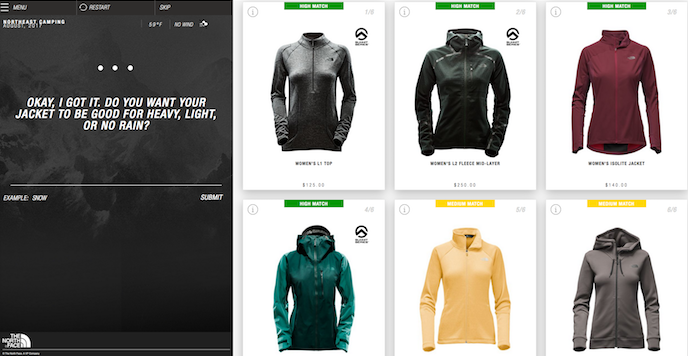
The North Face collaborated with IBM to offer AI in the form of a friendly personal shopper who asks organically-poised questions. You don’t have to log-in or register to use this feature. The shopper begins by asking a series of questions: Where will you be using this jacket? What for? And when? We replied that we’d like a jacket for a camping trip in the Northeast in August. The shopper returned with the average temperature at night in the region in August – 59F – and a selection of jackets.
To the left of the jackets was another question about rain. We wrote that we’d like the jacket to be good for light rain, and the shopper updated our selection. It continued to ask questions and refine the jackets based on our answers: Yes to zippered pockets, a hood, and active fit. The process mirrored the exchange we would have with a sales professional in a physical store. The questions glided along, and we saw the benefit of an improved focus to our search with every answer.
And in the end, we were shown one jacket designated for our camping trip. This one looks like it will work well for our plans. If we didn’t like it, however, we could have restarted the process anytime in the questioning.
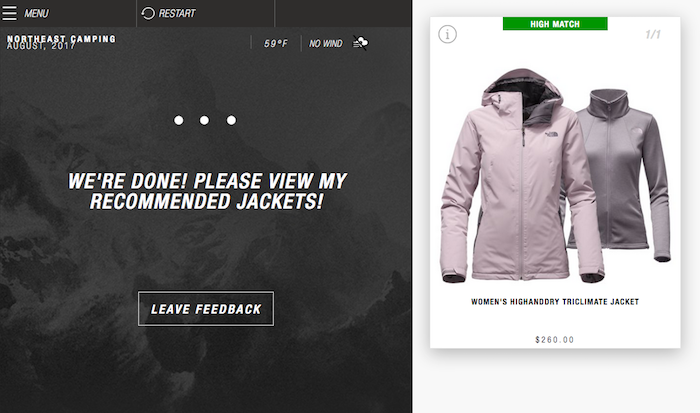
Swelly Bot: What’s Your Opinion?
AI is the engine behind another technology that helps customers make purchase decisions: chatbots (think “chatty robot”). Thus far, the most familiar chatbots in online shopping answer basic questions via chat using information found onsite, i.e. return policy. But chatbots are quickly becoming more sophisticated in their responses, as shown in the example of Swelly.
With Swelly and other up and coming bots like it, the chatty robot responds in more natural, human language. Also, they’re moving beyond information simply found onsite. In the case of Swelly, it’s able to crowdsource the answer to your dilemma from other users.
Here’s how Swelly worked for us. In shopping for a wedding guest look for this summer, we had a couple of options in mind: a Tory Birch pant suit or a Japanese-inspired gown. Using Facebook messenger, we installed Swelly and uploaded photos of the two outfits up for consideration.
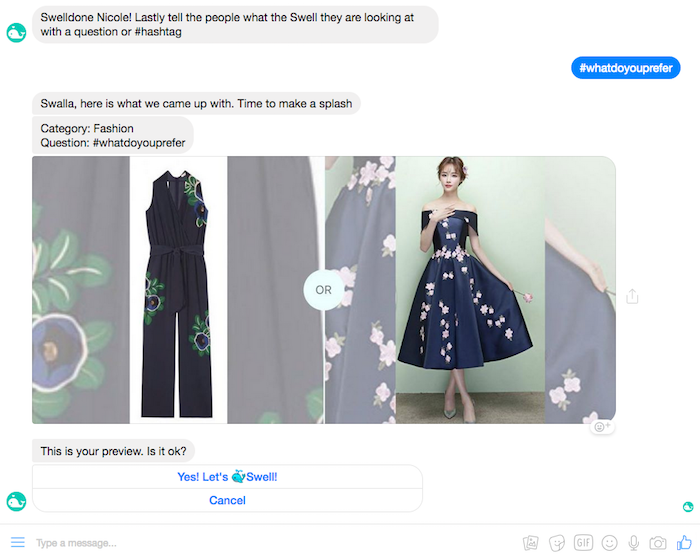
Once we selected the hashtag #whatdoyouprefer from Swelly’s range of hashtag options, our photos went out into the Swelly community of users. Three hours later, the Swellies had spoken.
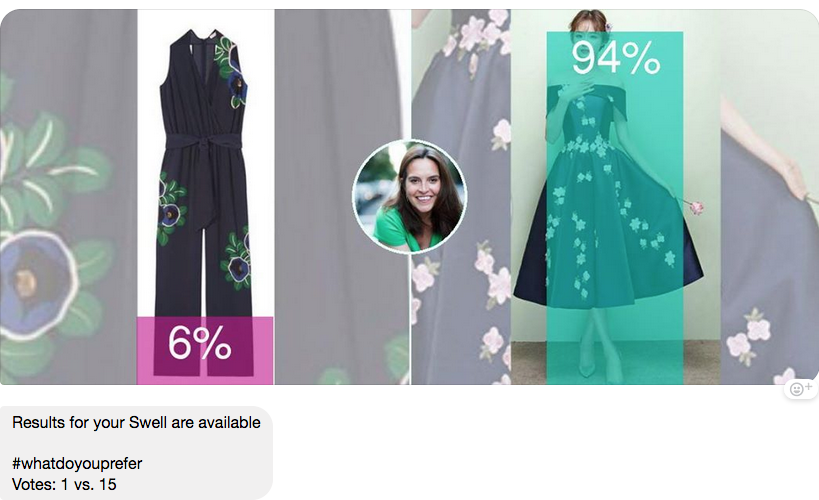
Last year Swelly was named Editors Choice Bot by Venture Beat. The site also lists Swelly as having 1.8 million users, but we had a modest return on our query (16 users). Regardless of the size of community, however, the technology of using chatbots to crowdsource opinions on purchases and other decisions is emerging.
At this year’s Shopify Unite conference, Shopify announced they are partnering with Kik, a messaging service much like Facebook messenger, that’s popular among teenagers. Kik has its own bot dashboard, where developers can customize bots. As a result of the Kik collaboration, Shopify merchants will soon be able to develop customized bots for their stores.
Neiman Marcus: Visual Search
Powered by technology from Slyce, the Neiman Marcus app allows customers to “Snap. Find. Shop.” for products they want. Soon after we learned of their Visual Search feature, a friend came a-visiting with a beautiful handbag. We’d like to have one like it, so we gave the Neiman Marcus app a try. We took a photo of our friend’s bag, and uploaded it to the app. As it searched for comparable bags, the apps said “Our stylists are pulling it off the rack…”. Nice touch.
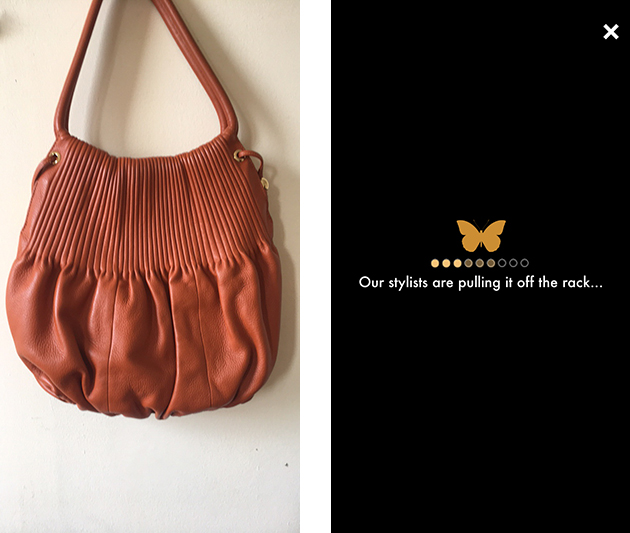
Within seconds, we had 30 bags from Neiman Marcus based on our photo. That’s an excellent number; it’s a good selection without being an overwhelming number of returns. Here are the first four bags that came up, along with the bag that will most likely make it over our shoulder soon. While the returns weren’t super precise – the color is slightly different and some of the shapes aren’t right – the NM app communicated the look and feel we wanted. We look forward to seeing this technology improve!

Visual Listening: Talkwalker
As we use our photos to search brands, it’s not surprising to find out this is becoming a two-way exchange. A new field of development is Visual Listening, where brands survey customers’ public photos for product interactions and opinion. This is possible through programs like Talkwalker that use AI to learn to recognize and catalogue brand logos. According to the Talkwalker website, “Every day over 1 billion photos and images of brands and products are posted on social and online.”
They go on to explain that approximately 80% of these posts do not contain a text mention of the brand — only an image. As a result, a merchant may have a Google Alert set up for online mentions about her brand, however, if it’s an image, Google won’t pick it up. But Talkwalker will. Customers have been sharing product photos for years, but the technology to read logos and other product elements hasn’t been available until now.
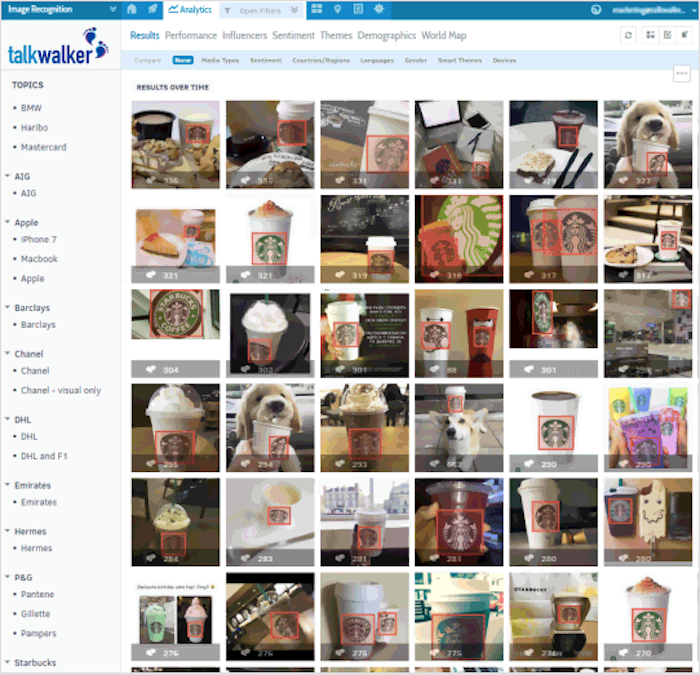
Even if a company is too small to have worldwide mentions online (yet!), it’s easy to see how an entrepreneur could use this technology to follow trends related to her products. What new looks are people cheering or what product fails are they deriding? It’s so useful because this feedback comes from a collection of voices, rather than from one person in a typical review.
In all these examples, we’re sharing about new technology in development. Not every one is right for every company, but it’s exciting to envision how ideas like these could be great for our clients. If you’re ready to explore new tools for your online store, please be in touch.
